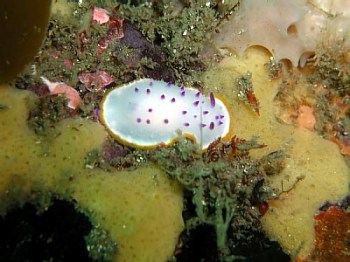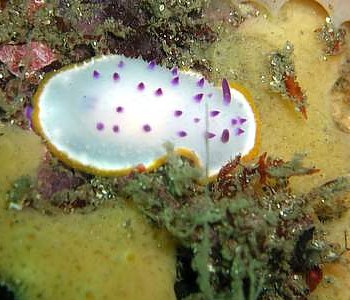Re: Mexichromis from Sagami Bay, Japan
August 11, 2001
From: Nishina Masayoshi


Dear Dr.Rudman,
Thank you very much for your comment on my animal. Before I sent the photo to you, I checked all your comments about Mexichromis on this Forum and etc. As you say, the comment confused me very much.
All my friends said that my animal is Mexichromis festiva. Although we need to see the radular teeth to be sure, I thought it's not Mexichromis festiva from your comment that "the purple spots are not noticeably raised." in M. festiva. I agree that "closely spaced pointed tubercles on the mantle are unusual". It has more pointed tubercles than M. festiva that I can see in photos on other sea slug sites and ID books.
I have attached a photo of the same specimen that I already sent a photo of. It was apparently feeding the yellowish brown sponge at the time.
Best Regards,
Nishina Masayoshi
nishina@hpe15.wips.co.jp
Nishina, M., 2001 (Aug 11) Re: Mexichromis from Sagami Bay, Japan. [Message in] Sea Slug Forum. Australian Museum, Sydney. Available from http://www.seaslugforum.net/find/5036Dear Nishina,
I think it is best to say that we don't know enough about this group of species at present and so any species names we give them are tentative. Mexichromis festiva was first described from New South Wales, Australia, and I have never seen an animal in New South Wales that looks like yours. Perhaps there is one very variable species, but at present we don't know. Thanks very much for the photo with the possible sponge food. In eastern Australia Mexichronis is usually found on a purplish grey sponge, which is probably a Dysidea sp.. Mexichromis festiva has direct development [see egg ribbon photo] so any information on the egg ribbon of your animal would be useful.
When we have taxonomic puzzles like this, where there may be a number of species with variable colour patterns, I think the best thing to do is to have a look at what is happening at a particular location. If we can understand what is happening in a single population then we have a better chance of understanding what is happening in the whole of the Indo-West Pacific. For example, just how much variation do you see? Do your animals always have a continuous orange border or is it sometimes broken into spots? Do you sometimes have animals which have no purple spots? Do your animals always have the pointed tubercles?
Obviously these are not questions you can answer immediately, but they are the type of question which is worth remembering, so that next time these animals are around, you will know what to look our for.
best wishes,
Bill Rudman
Related messages
-
Mating Mexichromis mariei in Bali, Indonesia
From: Paul Osmond, August 13, 2007 -
Mexichromis mariei? From Izu Hanto, Japan
From: Jon Ellis, April 13, 2007 -
Variations in Mexichromis mariei
From: Francis and Pirjo Pellet, February 20, 2004 -
Mexichromis mariei? from Japan
From: Kunihiro Takahashi, February 11, 2004 -
Mexichromis from Sth Korea
From: Dong Bum, Koh, March 26, 2003 -
Re: Noumea subnivalis? from Japan
From: Nishina Masayoshi, November 16, 2002 -
Mexichromis from Sulawesi
From: Mary Jane Adams, July 16, 2002 -
Mexichromis mariei? from Japan
From: Nishina Masayoshi, April 24, 2002 -
Mexichromis mariei from Bali
From: Stuart Hutchison, February 24, 2002 -
Re: Noumea subnivalis? from Hachijo Id
From: Nishina Masayoshi, November 13, 2001 -
Noumea subnivalis? from Japan
From: Nishina Masayoshi, November 7, 2001 -
Re: Mexichromis from Sagami Bay, Japan
From: Bernard Picton, August 11, 2001 -
Mexichromis from Sagami Bay, Japan
From: Nishina Masayoshi, August 8, 2001 -
Chromodoris? or Mexichromis sp from Okinawa
From: Kazuko Matsuda, August 4, 2000 -
An unspotted Mexichromis? from Kerama Is
From: Atsushi Ono , July 22, 2000 -
Mexichromis sp. from Okinawa
From: Robert F. Bolland, December 23, 1999 -
Re: The Mexichromis mariei story
From: Mike Miller, January 20, 1999
